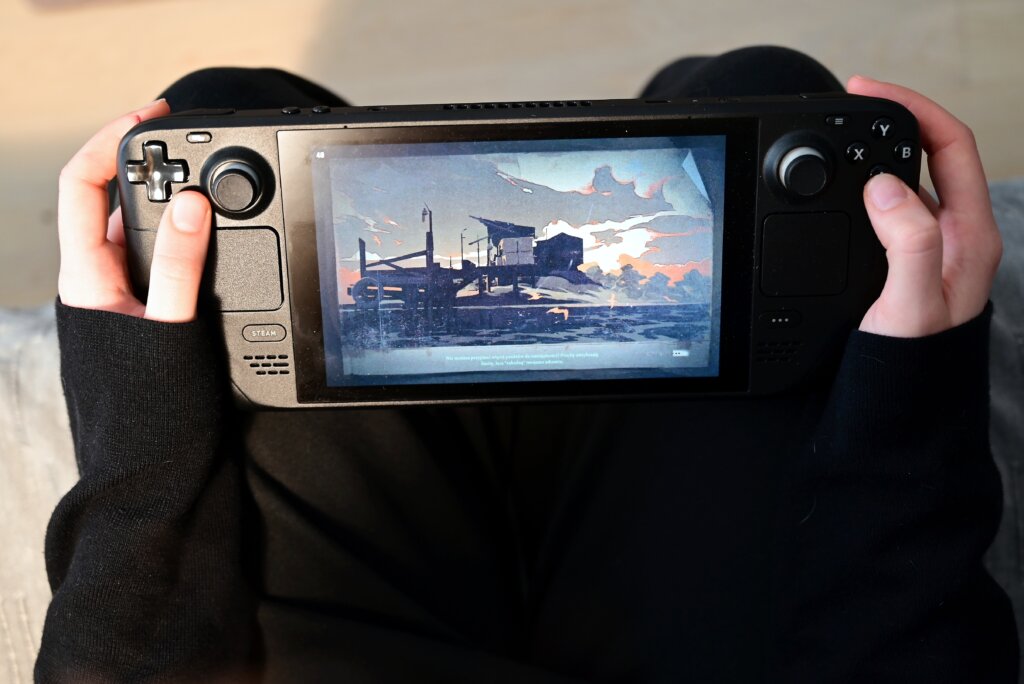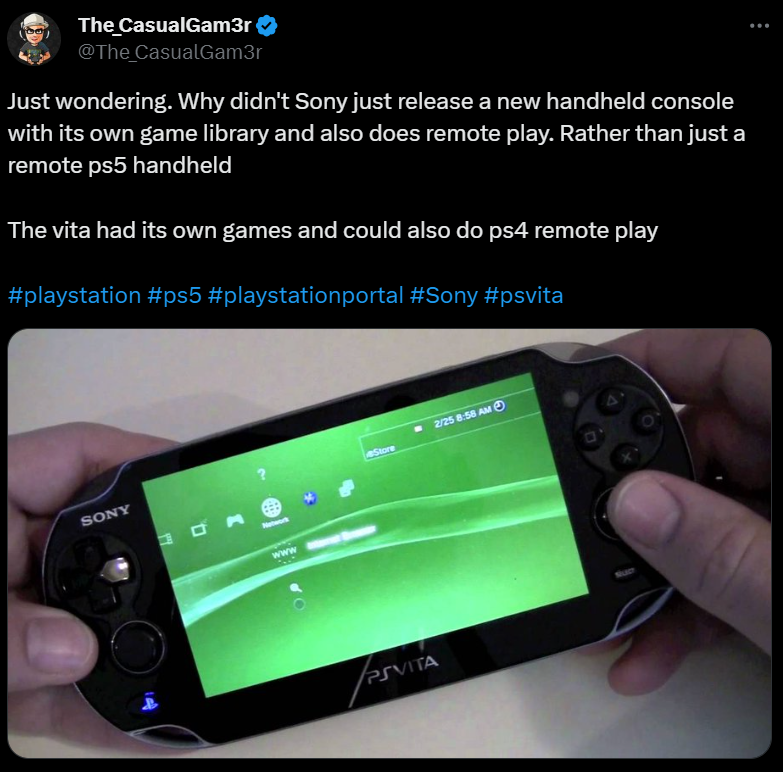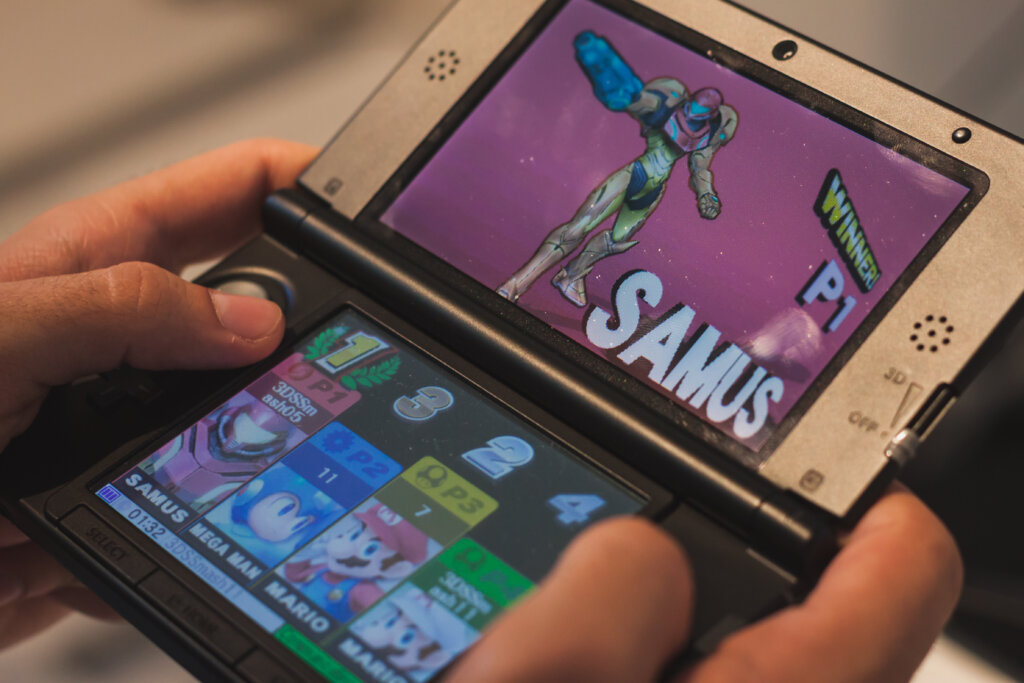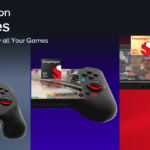
Sony introduces the new PlayStation Portal. (Source – YouTube)
Sony introduces a new handheld gaming device – but will it succeed?
- The Sony PlayStation Portal enters handheld gaming market, focusing on streaming PS5 games.
- Sony’s PlayStation Portal targets a competitive market, challenging the likes of Nintendo Switch and Steam Deck.
- Can the Portal go beyond the memory of the PS Vita?
This week, Sony is poised to make waves in the gaming world by launching its latest innovation: the ‘PlayStation Portal.’ This new handheld gaming device is set to revolutionize how gamers interact with their favorite PS5 titles. Featuring an 8-inch display, the PlayStation Portal is designed to stream PS5 games seamlessly over a wi-fi connection, leveraging Sony’s advanced Remote Play technology.
This device will let PS5 owners dive into their console games from virtually anywhere, provided they can access wi-fi. But it’s important to note that this streaming capability is restricted to games on the user’s personal PS5, not extended to cloud-based gaming services.
Design and features from Sony’s new handheld gaming device
The design of the PlayStation Portal is a nod to Sony’s renowned DualSense controller, with a form factor that feels both familiar and innovative. Gamers who have experienced the DualSense controller will instantly recognize the ergonomics and design language in the Portal. It’s as if the DualSense has been cleverly split and expanded, creating space for a vibrant 16:9 touchscreen at its center.
The device retains the signature features of the DualSense, including its sophisticated haptic feedback and adaptive triggers, which promise to deliver an immersive gaming experience.
One caveat of the Portal mirroring the DualSense’s design is the potential for analog stick drift, a common issue observed in gaming controllers with heavy or prolonged use. This issue is also present in the high-end DualSense Edge, although Sony has attempted to mitigate it with modular, replaceable stick components. How the Portal will address this concern over its lifespan remains to be seen.
Comparative analysis: PlayStation Portal, Steam Deck, and Nintendo Switch
The PlayStation Portal might give off an initial impression of bulkiness, but it’s surprisingly manageable in weight. The Verge has reported that the device tips the scales at around 530 grams.
That weight places it in a comfortable middle ground: heavier than the Nintendo Switch OLED model but noticeably lighter than Valve’s Steam Deck. The Portal’s design incorporates large, ergonomic grips that, while contributing to its weight, offer enhanced comfort for prolonged gaming sessions – a crucial factor for handheld devices.
To put the Portal’s performance in context, especially in comparison to its contemporaries like the Steam Deck and Nintendo Switch, a detailed analysis is insightful. The Steam Deck, Valve’s foray into handheld gaming, boasts significantly more power than the Nintendo Switch, a console that has not seen a significant hardware update since its release in 2017.
This disparity in hardware capabilities might seem significant, but these technical differences often don’t translate into a noticeable impact on the gaming experience for the average consumer. This is especially true in the long term, where gameplay and content availability tend to outweigh raw hardware performance.
Even within the Steam Deck’s lineup, there’s an ongoing evolution, with multiple models offering the same core performance but differing in other aspects. These variations represent Valve’s commitment to refining the Steam Deck experience, addressing user feedback and technological advancements.

The Steam Deck boasts significantly more power than the Nintendo Switch. (Source – Shutterstock)
In terms of battery life, an essential aspect of any handheld device, both the Nintendo Switch and Steam Deck face similar challenges. Despite the Steam Deck’s extensive settings and customization options, its battery life struggles to meet the demands of intensive gaming sessions. This limitation is a significant consideration for gamers prioritizing portability and uninterrupted play.
On the other hand, the Nintendo Switch has always grappled with battery limitations. With a capacity of just over 4000mAh, it often struggles to provide more than a few hours of gameplay on a single charge. This issue is compounded by its slower charging speed, resulting from its launch timing just before the widespread adoption of updated USB-C standards. This charging inefficiency often means prolonged downtime for gamers, impacting the overall user experience, especially for those who rely on their Switch for long commutes or travel.
Learning from the Sony PS Vita handheld gaming device challenges
It will be interesting to see how the new PlayStation handheld device will do – considering that Sony’s last attempt, the PS Vita, didn’t do well. The PSP, Sony’s earlier handheld device, sold a remarkable 80.79M units worldwide, setting high expectations for the Vita’s success. Launched on February 15, 2012, the Vita couldn’t replicate this success, with sales totaling around 15.82M units when Sony discontinued it in 2019. This significant decline was perceived as a major setback for Sony in the handheld gaming space.
The PS Vita’s struggle was multi-faceted. High production costs and complexities in game development deterred many third-party developers from embracing the platform. Moreover, Sony’s own first-party studios seemed to shift their focus towards the then-upcoming PlayStation 4, further diminishing the Vita’s appeal. The lack of robust third-party support and a substantial game library contributed to Vita’s limited success.

Would this work or could it be another failure like the PS Vita? (Source – X)
When asked about the Vita’s challenges, Sony attributed its underperformance to the burgeoning mobile gaming market, which was gaining significant traction during the Vita’s lifespan. Shuhai Yoshida echoed this sentiment from PlayStation at EGX 2015, where he remarked on the unfavorable conditions for portable gaming systems due to the dominance of mobile gaming.
Indeed, the rise of mobile gaming was a notable factor during the PS Vita era. Smartphones were rapidly advancing in their capabilities, offering a range of games that extended far beyond essential titles. This surge in smartphone gaming, coupled with the global increase in smartphone ownership, positioned mobile devices as dominant players in the portable gaming market, raising questions about the necessity of a separate, dedicated handheld gaming device like the Vita.
The Nintendo 3DS was just so good
In contrast to the PS Vita’s challenges, the Nintendo 3DS was thriving in the handheld gaming space. Launched just a year before the Vita, the 3DS had already carved out a significant market presence. Its success was driven by compelling games, such as Pokémon, Animal Crossing, and Mario Kart, which were ideal for handheld play. The 3DS’s design, with its clamshell form factor allowing for instant game pauses, catered well to the needs of mobile gamers.
The 3DS’s advantage wasn’t just in its game library, but also in its user-friendly design. The ability to pause and resume games quickly with the flip of its lid was a feature that resonated with gamers on the move. This level of convenience and the device’s established market presence made it difficult for the PS Vita to secure a foothold in a market already dominated by a well-loved competitor.

The Nintendo 3DS was a fan favorite because of its user-friendly design. (Source – Shutterstock)
Furthermore, the Nintendo DS line’s legacy in handheld gaming cannot be overstated. Its enduring popularity and diverse game library have cemented its place in gaming history. For those new to the Nintendo DS world, exploring its most popular titles offers a glimpse into a rich and varied gaming legacy.
Given these historical insights, the PlayStation Portal’s launch represents a critical moment for Sony in the competitive handheld gaming market. The Portal’s introduction suggests a renewed commitment by Sony to the portable gaming space, a sector it previously struggled to dominate with the PS Vita.
This time, however, the Portal’s integration with PS5 games and its unique design might offer Sony a distinct advantage. It reflects an understanding of the modern gamer’s needs: flexibility in gaming anywhere without sacrificing the immersive experience of console play.
READ MORE
- Safer Automation: How Sophic and Firmus Succeeded in Malaysia with MDEC’s Support
- Privilege granted, not gained: Intelligent authorization for enhanced infrastructure productivity
- Low-Code produces the Proof-of-Possibilities
- New Wearables Enable Staff to Work Faster and Safer
- Experts weigh in on Oracle’s departure from adland






